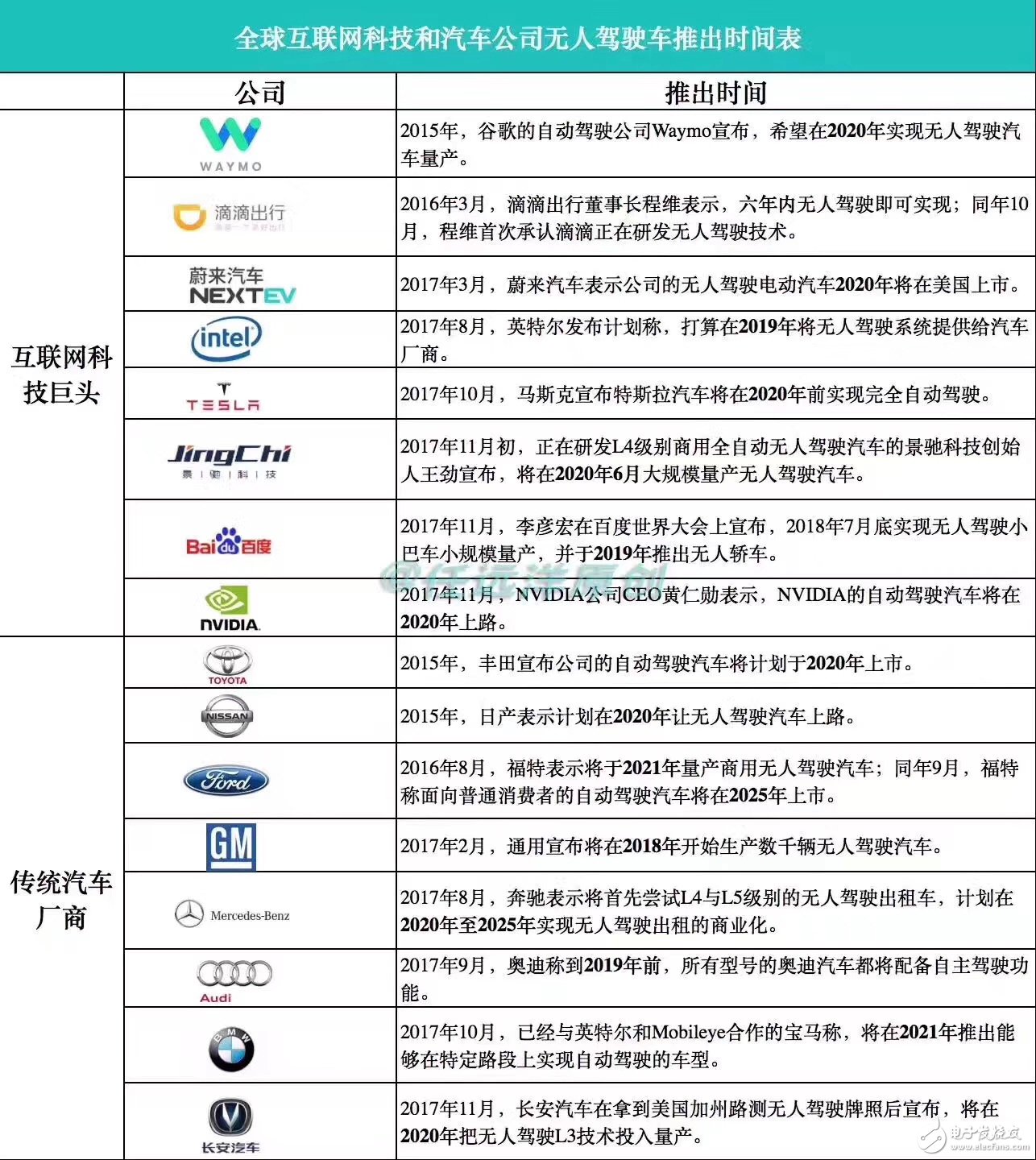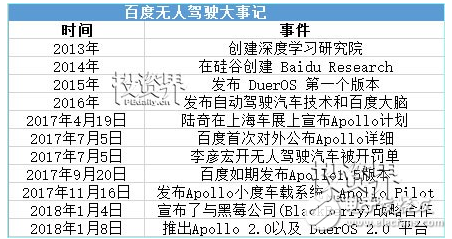How many smart cars will appear in the future city, no one can clearly estimate. What is certain is that the world is marching into the "no man" era with great fanfare. Whether it is engineers, entrepreneurs, scientists or investors, the degree of demand for industry talents and the strength of open capital support, only in 2018 The blockchain can suppress the unmanned wind. Let's take a look at the related content with the car electronics editor.
On March 1, SAIC and Weilai just obtained the license for the road test of unmanned vehicles in Shanghai. On the 7th, Baidu Li Yanhong told the media that he was applying for a license and would implement the road test in the first half of this year.
the other side,
Jingdong and SAIC Datong and Dongfeng Motor have developed new energy unmanned trucks and electric unmanned trucks;
Alibaba teamed up with SAIC to establish a Zebra smart solution;
Tencent Guangzhou Automobile has launched a number of smart car travel areas;
Huawei Dongfeng Motor cooperates to build a "smart car"...
Suddenly, the spring breeze comes, and thousands of trees and pears bloom. How many smart cars will appear in the future city, no one can clearly estimate. What is certain is that the world is marching into the "no man" era with great fanfare. Whether it is engineers, entrepreneurs, scientists or investors, the degree of demand for industry talents and the strength of open capital support, only in 2018 The blockchain can suppress the unmanned wind.
“Traditional driving schools will gradually disappear, professional drivers may be reduced, insurance premiums will drop, trainers will become IT experts, and space in the car will change into consumption scenarios...†After only a few years, the story has begun to undergo earth-shaking changes.
8 major manufacturers of the 8 giants, "China speed" can not be ignored
Whose voice is the loudest in the market? It’s hard to say. All parties have resorted to full horsepower to cater to this huge vent.
Because before the new pattern has not yet formed, who is the first to land, who is the boss.
According to incomplete statistics, at present, there are at least eight Internet giants and eight automobile manufacturers in the development of driverless cars.

At the CES at the beginning of this year, Baidu first revealed new developments in its latest achievements: Apollo and DuerOS. Apollo was officially released in April, and it was developed to version 2.0 in just 9 months. It will open training data and autopilot software to developers free of charge, providing developers with API, SDK, including perception system, path planning, vehicle control. Waiting for driverless ability. Became one of the biggest achievements in the global unmanned field.
Baidu's partners in the driverless field are even more eye-catching: there are many leaders in the field such as Bosch, Blackberry, Microsoft and Ford. In the early stage of industry development, Li Yanhong is bound to show the world "Baidu Super Speed".

But Baidu still has a lot of pressure to face other sounds in the market. For example: Tencent, Ali, or newcomers, like Wei Lai, Jing Chi, Didi...
The appearance of Wei Lai claimed to be aligned with Tesla, and the founders who brought the halo gave it very high hopes: Li Bin, founder of Yiche.com, Li Xiang, founder of the car home, and Tencent behind it. Gaochun Capital and Shun Capital.
In March 2017, Weilai said that the company's driverless electric vehicles will be listed in the US in 2020. If the market is successful, on the one hand, the unmanned landing will be pushed to the climax, and more importantly, the capital players behind it will be rewarded. In order to achieve the ambitious goal, capital is bound to support the unmanned R&D of Weilai Automobile more quickly and adequately. The strength cannot be underestimated.

In addition to these relatively mature companies, there is also a company that has become the most talked about in the driverless field - Jingchi Technology.
Because the dispute with Baidu was not cleaned up and messed up, Jingchi boarded the countertop. Even if the result was Wang Jin’s departure, Baidu’s Zhao’an Jingchi, except for the gossip, only the Pre-A wheel’s Jingchi became "Representative" in the human industry. The eyes of the market have all been transferred to this team: the background of members is luxurious, the technology foundation is high, the growth is rapid, the technical solutions of unmanned vehicles, intellectual property based on software and algorithms, technology licensing, joint design development and operation. Wang Jin’s flag of “the mass production of driverless cars in June 2020†is still worth looking forward to.
On the international front, the ambitions of the giants with strong technical foundations are also clear. Google has been involved in driverless technology in 2009. Google's unmanned vehicles are longer in test mileage, more experienced, and relatively mature in technology compared to other companies around the world. The company's driverless cars have undergone numerous upgrades and have accumulated 10,000 to 15,000 miles of autonomous driving test miles per week. Google's autonomous driving company Waymo also announced in 2015 that it hopes to achieve by 2020. Mass production of driverless cars, it is likely that a Google unmanned car will appear at the door of each household in the future.
Including Tesla, Intel, and NVIDIA are constantly testing the water, striving for the car to achieve freedom as soon as possible, and running on the road.
The proposal will be on the "two sessions" and the policies will be "on the road".
Macro policies always listen to the voices of the market.
“Building a new highland for autonomous driving policy and building a 'Chinese car brain' platform†This is an important proposal of Li Yanhong on artificial intelligence at the two sessions.
In the early days of the technology industry, Li Yanhong’s words put the attention of unmanned driving at a new height.
China’s policy response is not slow. At the end of last year, Beijing issued the Guiding Opinions on Accelerating the Work of Road Testing for Autonomous Vehicles and the Guideline for the Implementation of Road Test Management for Autonomous Vehicles. In the opening year of 2018, the Shanghai area took the lead in Beijing and issued the first batch of intelligent networked open road test number plates in China. At the same time, relevant test roads were delineated. Made in China 2025 requires domestic companies to take the initiative in ten key strategic industries such as artificial intelligence and robotics.
In the big environment, the policy is not backward, but compared with more than 20 states in the United States, laws and regulations related to autonomous driving have been introduced. Dubai has put unmanned taxis into use, and EU unmanned vehicles have entered the field scene detection. The British government is in 2021. Achieving unmanned driving years ago... Only China and Beijing and Shanghai have introduced relevant test regulations, and China’s policy promotion is still inferior.
As Li Yanhong said: "This is not enough. The car is a big industry, involving many links. For example, autopilot HD maps, anti-hacking problems for unmanned vehicles."
In Li Yanhong's view, the government does not need to worry about building a car, because the giant companies are already chasing after you, not tired. Instead, the government needs to give more macro support to start big things on roads and infrastructure, such as reducing the difficulty of technical development of autonomous driving.
"Non-guest" is easier to land, overflowing the market will be trillions of magnitude
"Dare to be the first in the world" must overcome a series of problems.
For the driverless car, if you run 100 billion kilometers, you can ride safely. But Google, which is at the forefront, has only tested 6.44 million kilometers, and it is hard to say how safe it is.
"There is a lot of sensory technology in it. The car is on the road. It must be able to sense where there is a car in front and where the car goes. But the game of Go is not perceived." Wu Enda unabashedly mentioned the driverless problem lies in.
Although artificial intelligence is the basis of unmanned technology, unmanned applications are more complex than artificial intelligence. Those so-called blind spots and technical opacity are closely related to life. When Google’s self-driving car crashed, Uber’s self-driving car was running red lights and driving directions were wrong. Tesla’s autopilot caused the driver to die. These serious accidents will greatly affect people's trust and expectation of autonomous driving technology. In China, more than 260,000 people die each year from road traffic accidents. Under a conservative attitude, the society must actually accept unmanned vehicles to overcome certain psychological obstacles.
With the development of technology, the safety factor will eventually reach the standard. The maturity of high-precision maps, the perfection of in-vehicle communication modules, and the integration of sensors will make the landing more clear. It is only easier to achieve mass production of “non-guest†unmanned vehicles in the short term.
In December 2017, the unmanned bus in Shenzhen was on the hot search. Its emergence has made the development prospects of unmanned vehicles more likely.
For example: scenic sightseeing cars, garbage trucks, clean road cars, etc.
Some research institutes predict that the scale of China's smart car market will reach 60 billion yuan in 2020. In the future, driverlessness will not only cause changes in the field of travel, but even the logistics industry and the environmental energy industry will be affected. Whether it is passenger or non-carrier, this will be a trillion-level market.
Unmanned driving will have a huge spillover effect, which will have a huge impact on the car, transportation, logistics, energy, real estate and other industries. By that time, it is no longer a breakthrough in automotive technology, it will open up new consumer scenes, and the activities in the car will be more abundant: unexpected things such as catering, service, entertainment, office, etc. will happen one after another.
However, it still takes time to give us the answer.
Conclusion
From the initial curiosity, to the subsequent academic research, to the real technology landing, to satisfy the curiosity of the driverless change, but also to play the game with peace of mind. The traditional car manufacturers, technology giants, and capital alliances have become the trend of the times. The mutual bundling of all parties is bound to effectively promote the realization of the unmanned society. It is only in the transitional stage that the dust will be set off under the even balance.
The above is about the "China Speed" in the automotive electronics-unmanned trillion-dollar market. If you want to know more information, please pay attention to eeworld, eeworld electronic engineering will provide you with more complete and more Detailed and updated information.
live steaming social media apps like facebook,youtube,tiktok,android and iPhone wired wireless projection,LAN and wifi internet access,HDMI interface.live streaming becomes more and more popular with young people these days,with a global covid-19 comes,more and more people started to live broadcast in their home and office,for advertising their products,fans interaction as a internet celebrity,online performance,a live show,but it is not so convenient with their mobile phones,the screen is too small so that they can not see clearly,our big size screen solved this problem,by using wired and wireless mobile projection function,and other necessary tools,like camera,microphone,the lighting,a live streaming can be more efficiently and with more fun.and we design a movable bracket,you can move it to anywhere you like,to satisfy different necessities for different locations.
Wired Projection Scree,Live Streaming Big Screen,Lcd Touch Screen Monitors,Lcd Touch Screen Equipments
Jumei Video(Shenzhen)Co.,Ltd , https://www.jmsxdisplay.com
